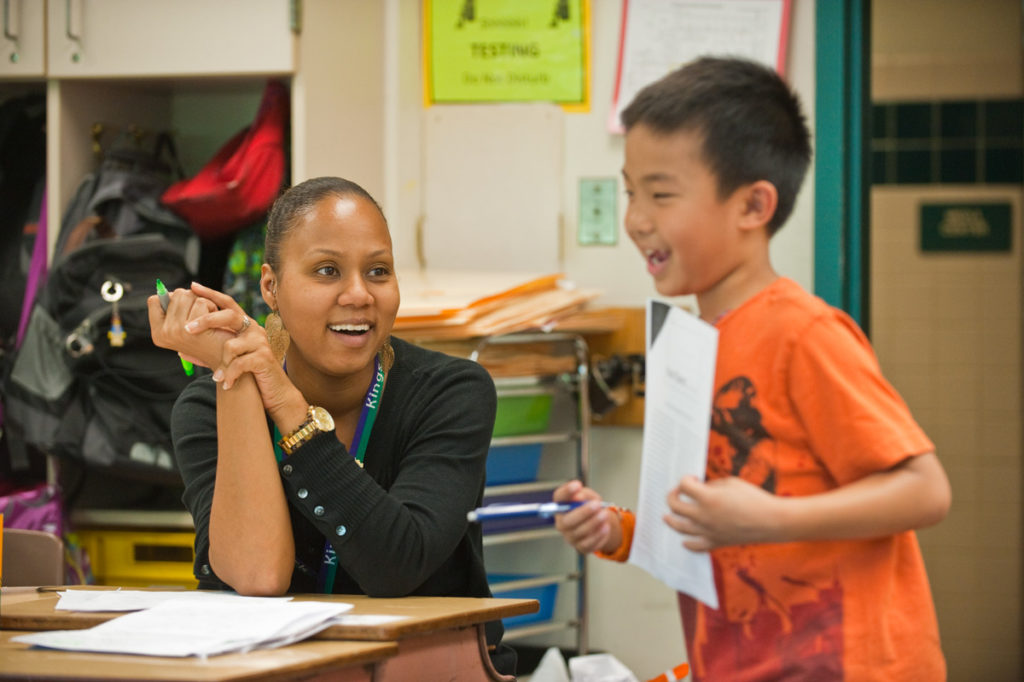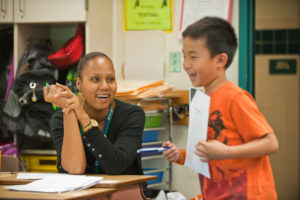

The combination of the teacher’s words and the teacher’s smile helps Joey feel comfortable and confident about returning to the school routine. Smiling broadly in affirmation, raising our eyebrows in surprise, or lowering our voice for dramatic effect are all clear sources of information to our students. In fact researchers in the field of nonverbal communication tell us that only about 7% of all communication is verbal; of the remaining 93%, 38% is vocal and 55% is facial (Mehrabian & Ferris 1967; Ekman & Friesen 1969).
Effective teaching requires that we pay a lot of attention to our verbal teacher language, using carefully chosen words to help build a positive and productive classroom community. But the way in which we deliver these verbal messages may contribute more to student understanding than the words themselves, particularly for children over the age of eight. Young children focus on the words that teachers use; older children tend to focus more on adults’ nonverbal behaviors in their attempts to understand “What does s/he really expect from me?” (Mayo & La France 1978).
Are we aware of the nonverbal behaviors we are using and are we sending the messages we intend? Following are some suggestions and ideas for using nonverbal behavior to improve your effectiveness in the classroom.
Ms. Rossi has a classroom full of energetic third graders. When she wants to begin a lesson she says, “I need all eyes on me.” She makes a point of looking directly at each child when she is speaking as well as when she is listening to their responses and questions. During the sharing component of Morning Meeting, she makes eye contact with a student who is about to touch the loose shoelace of a nearby student and then she points to the sharer. The fidgety student quickly returns her attention to the child who is sharing.
We acknowledge the importance of establishing and maintaining eye contact when we encourage children to make friendly and respectful eye contact with each other during Morning Meeting. But do we pay attention to our own use of eye contact? Making eye contact with individual students can help a teacher establish a presence in the classroom and reinforces the importance of the teacher’s message (Hodge 1971). It may also assist students in their ability to recall information. In one study, students whose teacher made eye contact with them while reading a story had greater recall of details of that story than students whose teacher did not make eye contact while reading the same story (Otteson & Otteson 1980).
Ask yourself: How often do I look directly at a child when I’m speaking with him/her? When I’m speaking to a group of children, how often do I make eye contact with individual children in the group? Raising your own level of consciousness is one way to begin making changes.
If you decide that you’d like to improve your use of eye contact, you can enlist the children’s help by letting them know that you’ll be practicing your use of eye contact during lessons with them just as they practice good eye contact during Morning Meeting. Simply letting the children know that this is a goal you’re working on can help keep you focused on the goal.
Nonverbal signals such as a raised hand for quiet can be extremely useful and effective in the classroom. But children need to know that a finger point means time-out, the light flicker means that quiet time is ending, or a finger to the mouth during Morning Meeting means “It’s time to listen.” At the beginning of the year, teach, model, and practice the nonverbal signals that you and the students will use and then throughout the year, be consistent in your use of those signals.
We’ve all been there—it’s mid-afternoon and the instructor is droning away at a lectern in the front of the room. Even as adults, our impulse is to fidget, snooze, whisper, or construct our grocery lists. Imagine what it’s like for children when we speak in a monotone voice?
Comprehensive studies indicate a relationship between paralanguage (voice tone, pitch, volume, tempo, intensity, silent pauses) and teacher effectiveness. Our voices are important instructional tools that we can learn to use in flexible ways. When we’re animated and vary the way we speak, we send a message that says “Hey, this is interesting. Pay attention.”
For example, try varying the ways you can say that well-known story opener “Long, long ago in a place far, far away . . .” Stretch out the words and insert a pause: “Lonnnng, lonnnng ago (pause) in a place farrrr, farrr away . . .” Or use a different pitch for the first “long” versus the second “long” and the first “far” versus the second “far” for a different effect.
One way to check on your paralanguage is to tape record yourself through a typical day. As you listen to the tape, pay attention to how often and when you vary the speed of what you’re saying, vary the volume, and vary the pitch and tone. Also pay attention to when and for how long you pause.
If you’d like to enliven the way in which you speak, you might begin by listening to good storytellers. (Check out some adult or children’s books-on-tape from your local library.) How do they use their voices to enhance the content of the story? Then as part of your daily lesson preparation, practice using your voice more flexibly. Consider using a tape recorder to check on your progress.
Have you ever had one of those conversations where you’re not sure what’s going on? For example, you’re working on a project with another teacher. You propose a course of action. Your colleague’s responding words are enthusiastic and indicate agreement but her facial expression, voice tone, and lack of eye contact say something quite different: “I really think this is a bad idea.” Which communication do you respond to?
Teachers and students show a lot of what they are thinking and feeling in their facial expressions. Students’ faces might show interest, concentration, or confusion, so observing their facial expressions can be a step towards assessing engagement and understanding. Likewise, our facial expressions might show impatience, disapproval, and irritation, all of which can confuse and discourage students, particularly since we’re often not aware of what—and how much—our faces show.
If our goal is to encourage and empower students, then we need to project our caring and support through our facial expressions. This doesn’t mean smiling sweetly all the time, even when we’re bothered by something a student does or says. It does mean letting our genuine concern for our students shine through consistently, during hard and easy moments. If you’re concerned about what your facial expressions communicate, you might ask a colleague to observe you and give you feedback.
Consulting teacher Ruth Sidney Charney emphasizes how important it is for teachers to “say what you mean and mean what you say.” (Charney 2002, 233–245) But since most of our message is projected nonverbally, I think it’s important to take that one step further: “Be sure that what you say and how you say it send the same message.” If you say “Time-out, Shari,” with a questioning inflection, Shari will be confused. Should she go to time-out or not? If you say “Remind me how we agreed to use the scissors” but furrow your brow in an angry way, you lose the nonjudgmental intent no matter how matter-of-fact your voice is.
The most effective way to assess verbal and nonverbal consistency is by videotaping yourself during a typical lesson. As you watch the tape, ask yourself: “Is what I’m saying in sync with how I’m saying it? Do the children seem to know what I expect or do I frequently need to repeat myself? Are my nonverbal signals as effective as I need them to be?” Many teachers have found that watching themselves on videotape offered unique insights into their own teaching style, which is an important step towards change.
Susan B. Rosa, EdD, is a certified Responsive Classroom presenter, long-time classroom teacher, and assistant professor of education at Franklin Pierce College in New Hampshire. Her doctoral research focused on nonverbal teacher/student communication in a primary inclusion classroom.
Martinek, Thomas; Patricia Crowe; and Walter Rejeski. 1982. Pygmalion in the Gym: Causes and Effects of Expectations in Teaching and Coaching. West Point, NY: Leisure Press.
Miller, Patrick W., PhD. 2000. Nonverbal Communication in the Classroom. Chicago: Patrick W. Miller and Associates.
Woolfolk, Anita E. and Douglas M. Brooks. 1985. “The Influence of Teacher’s Nonverbal Behaviors on Students’ Perceptions and Performance.” The Elementary School Journal. (85): 513-528.
Charney, Ruth Sidney. 2002. Teaching Children to Care. Greenfield, MA: Northeast Foundation for Children.
Ekman, Paul, and Wallace V. Friesen. 1969. “The Repertoire of Nonverbal Behavior: Categories, Origins, Usage, and Coding.” Semiotica (1): 49–98.
Hodge, R L. 1971. “Interpersonal Classroom Communication through Eye Contact.” Theory into Practice. (10): 264–267.
Mayo, Clara and Marianne LaFrance. 1978. “On the Acquisition of Nonverbal Communication: A Review.” Merrill-Palmer Quarterly. (24): 213–228.
Mehrabian, Albert, and R. Ferris. 1967. “Inference of Attitudes from Nonverbal Communication in Two Channels.” Journal of Consulting Psychology (31, 3): 248–252.
Otteson, J. P. and C. R. Otteson. 1980. “Effects of Teacher Gaze on Children’s Story Recall.” Perceptual and Motor Skills (50): 35–42.